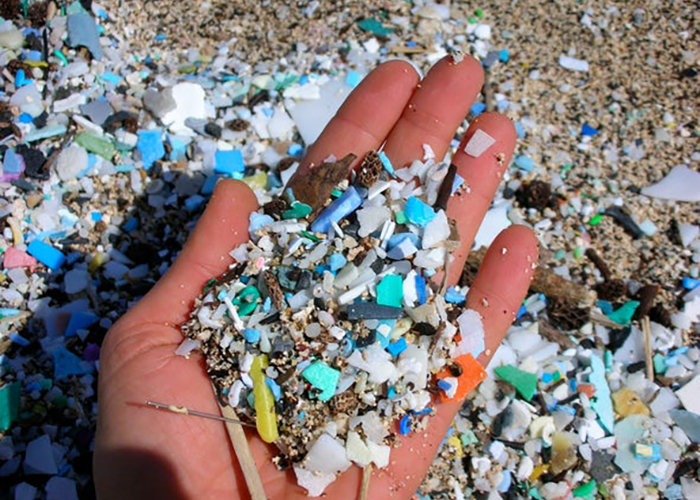Dr. Asha Singh
Since development of the plastics at the beginning of the 20th century, they have become indispensable in society. Plastics production has seen an exponential growth since its entrance in the market, rising from a million tons in 1945 to over 368 million tons in 2020. These plastics are discarded in vast numbers each day, and more recently, the breaking down of these plastics into micro- to nano-sizes has raised concerns among scientists. Surging dismissal of plastics into water resources results in the splintered debris generating microscopic particles called microplastics (MPs) via photo-oxidative mechanisms. National Oceanic and Atmospheric Administration (NOAA) now defines the term MPs as tiny ubiquitous plastic particles <5 mm in diameter. The reduced size of microplastics makes it easier for intake by aquatic organisms resulting in amassing of noxious wastes, in all forms of marine life ranging from zooplankton to whales.
MPs are dispersed into the ocean all over the world and even sea ice in the Arctic, and the Antarctic transported by ocean and wind. About 54.5% of microplastics floating in the ocean are polyethylene, and 16.5% are polypropylene, and the rest includes polyvinyl chloride, polystyrene, polyester, and polyamides. The world’s sea floor is littered with an estimated 14 million tonnes of microplastics, broken down from the masses of rubbish entering the oceans every year. Over the past recent years, scientists all over the globe have demonstrated the presence of MPs in all forms of marine life, in table salt, honey, sugar, and beer, in the dust, and most alarmingly, in bottled and tap water samples. Thus, the omnipresence of plastics in all aspects of human life means that humans are inevitably exposed to microplastics (MPs) on a daily basis.
Recently, polypropylene MPs were found to be released from infant feeding bottles in numbers as high as 16200 particles per millilitre after heat treatment, suggesting that MPs may pose an unknown risk to infant health. Similarly, tea bags were identified as a source of MPs releasing billions of microplastic particles for a single cup of tea, during 5 min of exposure to hot water. It is likely that 3 to 38 mg of primary MPs with cubic, spherical, rod-like and irregular shapes are consumed by humans or released into the environment during each use of a plastic food container.
As an emerging area of concern, MPs can enter the food chain through ingestion of seafood and terrestrial food products causing potential human health impacts. Microplastics might translocate into body tissues and cause harm, with the smallest size fraction (<1.5 mm) being more likely to penetrate deeply into organs. The physical impact of MPs creates devastating injuries to many forms of marine life from concretion of accumulated MPs in gills and intestines, thus interfering with feeding habits that unnaturally lead to death. Additionally, plasticizers in MPs have been linked to abnormal growth and reproductive problems from endocrine disruption and organic pollutants like pesticides; and metals like lead and cadmium leach into organisms that ingest MPs. Furthermore, pathogenic microorganisms colonized on the surface of ingested microplastics may serve as a vector of various diseases.
On the whole, ingestion of MPs by marine animals lead to adverse health effects including decreased food consumption, false satiation, decreased growth rate, reproductive complications, oxidative stress, decreased immune response, weight loss, pathological stress, blocked enzyme production that could potentially threat marine populations. Toxic chemical additives in the plastic which are of paramount concern for human health include phthalates, bisphenol A, brominated flame retardants (BFR), triclosan, bisphenone, and organotin. In human beings, polystyrene particles of the size 50 nm have shown genotoxic and cytotoxic effects on pulmonary epithelial cells and macrophages. The interaction of microplastics with humans can produce cytotoxicity, hypersensitivity, unwanted immune responses, and acute responses like hemolysis, thus representing a potential risk to human health.
During the COVID-19 epidemic, owing to concern about safety and cross-contamination a number of restrictions on single-use plastics have been paused and resulted into heightened demand for personal protective equipments (PPEs), bottled water, plastic bags and packaging. Surgical masks are made from various polymer materials like polyethylene, polyacrylonitrile, polypropylene, polyester, etc. Unless properly disposed, this extremely infectious litter from the COVID-19 pandemic will persist in the environment for decades and will eventually split into microplastics.
In order to tackle the destructive impacts of microplastics, low cost, high-quality, and environmentally sustainable plastic waste management is required. Policies to reduce single-use plastics including, ban on single-use plastic bags, drinking straws, deposit and return plans for plastic bottles, and Extended Producer Responsibility (EPR), which makes manufactures responsible for the entire product life-cycle, are positive steps that should be widely implemented. Circular economy principles have been extended to include the 6Rs (reuse, recycle, redesign, remanufacture, reduce, recover) for plastic waste management. Methods can be implemented before the microplastics get converted into nanoplastics by segregating the high-density plastics that accumulate at the bottom and the low density plastics that float at the surface of the water, to prevent further aquatic contaminations. In addition, considering the role of COVID-19 pandemic in microplastic pollutions, there is high need for environmentally responsible solutions in order to prevent a potential pandemic of microplastics.
(The author is Assistant Professor in Environmental Sciences Govt. Degree College Bishnah)
Trending Now
E-Paper


